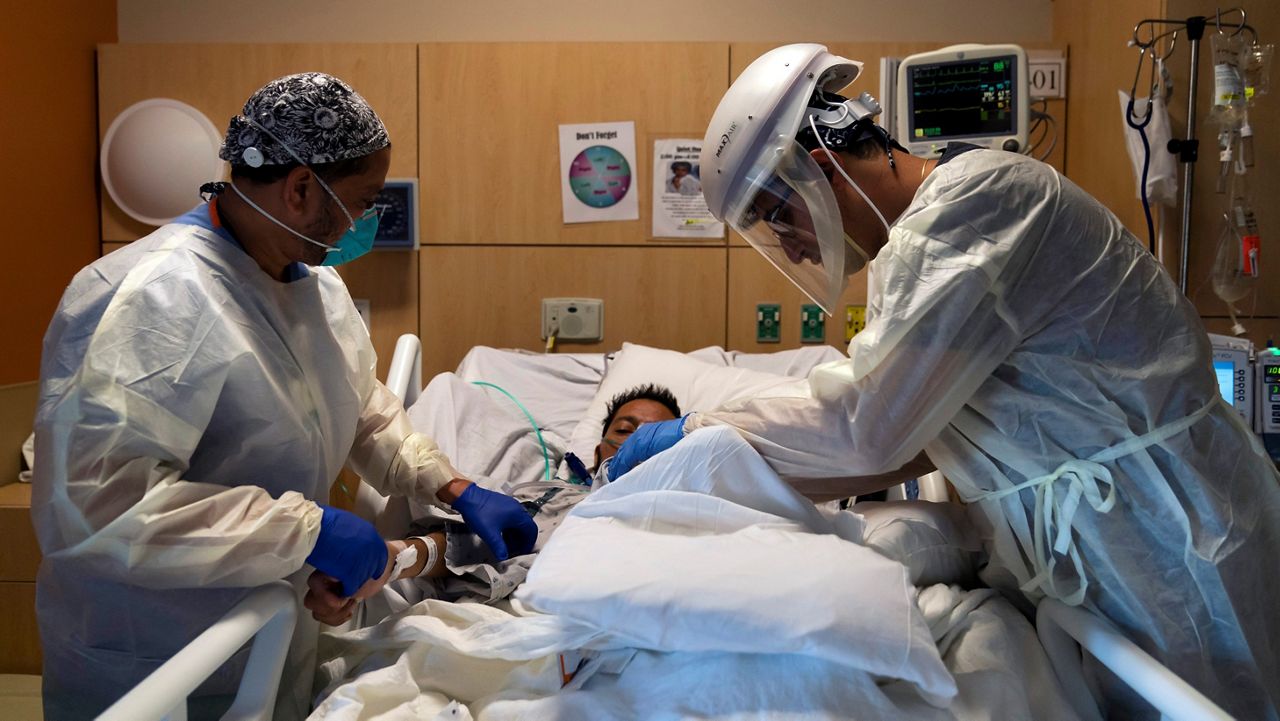LOS ANGELES (CNS) — Southern California will fall under sweeping new health restrictions Sunday night due to the rapidly increasing number of hospitalizations from the coronavirus, state officials said Saturday, as Los Angeles County saw a record-high number of new COVID-19 cases for the fourth time in the past five days.
A state-mandated "regional stay-at-home" order goes into effect at 11:59 p.m. Sunday, triggered when intensive-care unit bed availability remained below 15% after Saturday's daily update, according to the California Department of Public Health.
The 11-county Southern California region's available ICU capacity was 12.5% Saturday, a decrease from 13.1% the day before.
Gov. Gavin Newsom had said Thursday that the Southern California region could meet that 15% trigger within days. The Southern California region consists of Los Angeles, Orange, Riverside, San Diego, Imperial, Inyo, Mono, San Bernardino, San Luis Obispo, Santa Barbara and Ventura counties.
The stay-at-home order will be in place for three weeks and will bar gatherings of people from different households. Regions will be eligible to exit from the order on Dec. 28 if ICU capacity projections for the following month are above or equal to 15%.
Under the order, the following businesses/recreational facilities will be forced to close:
- indoor and outdoor playgrounds;
- indoor recreational facilities;
- hair salons and barbershops;
- personal care services;
- museums, zoos, and aquariums;
- movie theaters;
- wineries;
- bars, breweries and distilleries;
- family entertainment centers;
- cardrooms and satellite wagering;
- limited services;
- live audience sports; and
- amusement parks.
Schools with waivers will be allowed to remain open, along with "critical infrastructure" and retail stores, which will be limited to 20% of capacity. Restaurants will be restricted to takeout and delivery service only. Hotels would be allowed to open "for critical infrastructure support only," while churches would be restricted to outdoor only services. Entertainment production — including professional sports — would be allowed to continue without live audiences.
Some of those restrictions are already in effect in select counties.
Los Angeles County reported 8,949 new cases of COVID-19 and 44 additional deaths Saturday, the highest one-day total of new cases yet.
Hospitalizations continued rising at record levels, with 2,769 county residents hospitalized with the virus as of Saturday, the highest amount of the entire pandemic.
The county reported a record 8,860 new coronavirus infections on Friday, along with 148 announced by Long Beach and 93 by Pasadena — which have their own health departments.
Fatalities are also trending upward: Two weeks ago, the county's average number of daily deaths was 21.
California COVID-19, By The Numbers:
— CA Public Health (@CAPublicHealth) December 5, 2020
🔹 Confirmed cases to date: 1,311,625
🔹 Note: Numbers may not represent true day-over-day change as reporting of test results can be delayed
More information at https://t.co/TLLUGwPGY7. pic.twitter.com/T03p3jE9Aq
"This week, almost 49,000 people tested positive for COVID-19," county Public Health Director Barbara Ferrer said. "We can anticipate based on our experience, that 10% of newly infected individuals are likely to require hospital care a couple of weeks from now. That translates to close to 5,000 patients, and if even 20% of these patients need care in the ICU, they will require 1,000 staffed ICU beds. This is our likely reality in 2 weeks.
"And if we all can't get behind the existing directives to stay home as much as possible and avoid all non-essential activities and places where you are likely to be in contact with non-household members, we are likely to bear witness to one of the worst health care crises our county has seen in our lifetime. The reality is we can still prevent the continued increases in people suffering and dying if we focus all of our collective will on doing what we know how to do; this is the time to take care of each other, and to always wear a face covering and keep a physical distance of at least 6-feet when outside and around others."
The county has now logged a total of 439,408 cases of the coronavirus and 7,886 deaths.
Officials with the Los Angeles County Department of Public Health said the county's Health Officer Order will be modified to align with the State Regional Stay Home Order to prevent crowding and mingling among non-household members and overwhelming the local health care system.
Newsom said the new order is "fundamentally predicated on the need to stop gathering with people outside of your household, to do what you can to keep most of your activities outside and, of course, always ... wear face coverings, wear a mask."
The governor also noted that the state still has a travel advisory in place recommending against non-essential travel and urging people to quarantine when they return to the state.
Dr. Mark Ghaly, the state's Health and Human Services secretary, acknowledged there is no real mechanism for enforcing such a travel restriction, but the state will rely on public cooperation.
"We believe that really emphasizing this is what we hope our citizens will do because their communities are at particularly high risk, their hospitals are having difficulty keeping available ICU beds open, that people will restrict their travel statewide," he said.
The San Joaquin Valley will also enter the new shutdown protocol Sunday night, as its ICU capacity dropped to 8.6% on Saturday.
California has grouped its counties into five regions: The Bay Area, the Greater Sacramento Region, Northern California, the San Joaquin Valley and Southern California.
The state's full stay-at-home order can be read here.
COVID-19 Daily Update:
— LA Public Health (@lapublichealth) December 5, 2020
December 5, 2020
New Cases: 8,949 (439,408 to date)
New Deaths: 44 (7,886 to date)
Current Hospitalizations: 2,769 pic.twitter.com/e1hDshNoQt



